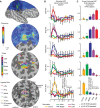Event-related fMRI at 7T reveals overlapping cortical representations for adjacent fingertips in S1 of individual subjects
- PMID: 24014446
- PMCID: PMC4216413
- DOI: 10.1002/hbm.22310
Event-related fMRI at 7T reveals overlapping cortical representations for adjacent fingertips in S1 of individual subjects
Abstract
Recent fMRI studies of the human primary somatosensory cortex have been able to differentiate the cortical representations of different fingertips at a single-subject level. These studies did not, however, investigate the expected overlap in cortical activation due to the stimulation of different fingers. Here, we used an event-related design in six subjects at 7 Tesla to explore the overlap in cortical responses elicited in S1 by vibrotactile stimulation of the five fingertips. We found that all parts of S1 show some degree of spatial overlap between the cortical representations of adjacent or even nonadjacent fingertips. In S1, the posterior bank of the central sulcus showed less overlap than regions in the post-central gyrus, which responded to up to five fingertips. The functional properties of these two areas are consistent with the known layout of cytoarchitectonically defined subareas, and we speculate that they correspond to subarea 3b (S1 proper) and subarea 1, respectively. In contrast with previous fMRI studies, however, we did not observe discrete activation clusters that could unequivocally be attributed to different subareas of S1. Venous maps based on T2*-weighted structural images suggest that the observed overlap is not driven by extra-vascular contributions from large veins.
Keywords: High-resolution functional MRI; Human; Somatosensory cortex; Tactile Perception.
Copyright © 2013 Wiley Periodicals, Inc.
Figures





References
-
- Andersson JLR, Jenkinson M, Smith SM (2007): Nonlinear registration, aka Spatial normalisation.
-
- Benjamini Y, Hochberg Y (1995): Controlling the false discovery rate: A practical and powerful approach to multiple testing. J Royal Stat Soc B (Methodological) 57:289–300.
-
- Benjamini Y, Krieger AM, Yekutieli D (2006): Adaptive linear step‐up procedures that control the false discovery rate. Biometrika 93:491–507.
-
- Biermann K, Schmitz F, Witte OW, Konczak J, Freund HJ, Schnitzler A (1998): Interaction of finger representation in the human first somatosensory cortex: a neuromagnetic study. Neurosci Lett 251:13–16. - PubMed
Publication types
MeSH terms
Substances
Grants and funding
LinkOut - more resources
Full Text Sources
Other Literature Sources

